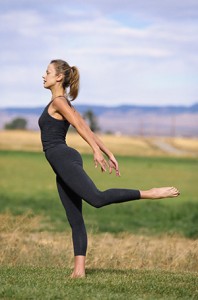
A rolfer evaluates the client’s body structure when standing and moving, identifying areas of existing tension and strain. The client then lies on a padded table and the rolfer uses fingers, knuckles and elbows to loosen bound-up connective tissues with carefully selected weight and specific techniques.
by Deanna Melnychuk —
There is no escaping that we live in a gravitational field. Ida P. Rolf, Ph.D., understood that poor postural alignment was the major cause of gravitational stress in the body. She believed gravity could promote balance and ease stress if a person’s body was in proper relationship with it.
Over 50 years, she developed a systematic approach to train rolfers to see how a person’s body structure is organized and how it moves through space. A rolfer looks for relationships between the upper and lower halves of the body; how the legs support the pelvis; how the pelvis supports the neck and torso. They check to see if the left and right sides match; if front and back body surfaces support each other; and if inner and outer surfaces relate well to each other.
A rolfer knows that when a body is balanced in all these aspects, it functions better, allowing a person better health, more energy and more efficient movement.
How does all this happen? A rolfer evaluates the client’s body structure when standing and moving, identifying areas of existing tension and strain. The client then lies on a padded table and the rolfer uses fingers, knuckles and elbows to loosen bound-up connective tissues with carefully selected weight and specific techniques. As the client’s body responds, the connective tissues stretch and lengthen.
“As constricted areas are released, circulation is improved and the client gains awareness of overall body balance. Unlike massage, the Rolfing process will actually change relationships between body parts, creating a structure that more comfortably reflects the individual.” (The Power of Balance: A Rolfing View of Health by Brian W. Fahey, Ph.D.)
Rolfing can help those with chronic conditions, who’ve been injured in accidents or have had surgery. After the 10 sessions, 75 to 90 minutes in length, the client may experience a feeling of being lighter, moving more efficiently, having “well-oiled” joints, as well as a release of chronic pain and heightened self-awareness. Their friends will see someone whose knees and feet track forward and parallel (no more duck feet); whose head sits upright on the shoulders (no more forward head) — someone who has a purposeful, easy stride; improved coordination and athletic ability.
Bring the power of balance into your life through rolfing.
Deanna Melnychuk, B.Sc., is a certified advanced rolfer and rolfing® movement practitioner, licensed massage therapist, Reiki Master, craniosacral therapist and reflexologist. 602-404-8685.
Reprinted from AzNetNews, Volume 24, Number 4, August/September 2005.





September 24, 2013
Bodywork, Injury, Natural therapies, Pain, Rolfing